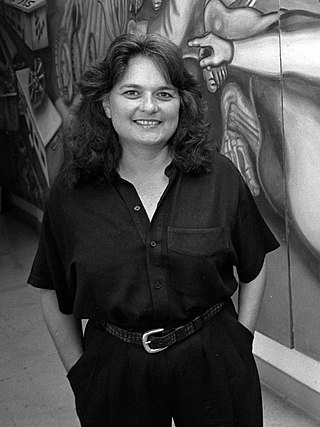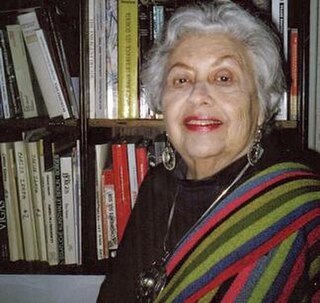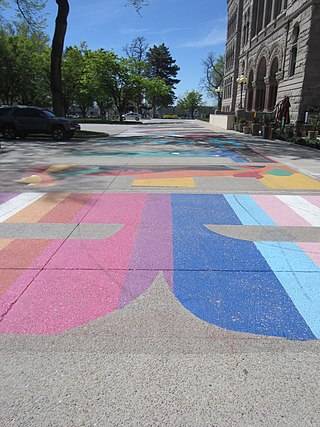Related Research Articles

The Royal Chicano Air Force (RCAF) is a Sacramento, California-based art collective, founded in 1970 by Ricardo Favela, José Montoya and Esteban Villa. It was one of the "most important collective artist groups" in the Chicano art movement in California during the 1970s and the 1980s and continues to be influential into the 21st century.
José Antonio "Tony" Burciaga was an American Chicano artist, poet, and writer who explored issues of Chicano identity and American society.

Judith Francisca Baca is an American artist, activist, and professor of Chicano studies, world arts, and cultures based at the University of California, Los Angeles. She is the co-founder and artistic director of the Social and Public Art Resource Center (SPARC) in Venice, California. Baca is the director of the mural project that created the Great Wall of Los Angeles, which is the largest communal mural project in the world.

Minerva Bernetta Kohlhepp Teichert was a 20th-century American painter notable for her art depicting Western and Mormon subjects, including a collection of murals depicting scenes from the Book of Mormon. Teichert received her art education from the Art Institute of Chicago and the Art Students League of New York. Teichert was a member of the Church of Jesus Christ of Latter-day Saints. Other religious-themed artwork she is known for include Christ in a Red Robe, Queen Esther, and Rescue of the Lost Lamb. Additionally, Teichert painted 42 murals related to stories in the Book of Mormon which reside in Brigham Young University's (BYU) Museum of Art. She was the first woman invited to paint a mural for an LDS Church temple.

Linda Vallejo is an American artist known for painting, sculpture and ceramics. Her work often addresses her Mexican-American ethnic identity within the context of American art and popular culture. The founder of the commercial art gallery Galería Las Américas, she is also an arts educator and has been involved intraditional Native American and Mexican rituals and ceremonies for many years.

The Chicano Art Movement represents groundbreaking movements by Mexican-American artists to establish a unique artistic identity in the United States. Much of the art and the artists creating Chicano Art were heavily influenced by Chicano Movement which began in the 1960s.

Shifra Goldman was an American art historian, feminist, and activist. She had a probing intellect and a sense of "brutal" honesty. She also had an "encyclopedic" knowledge of art history and a passion for Chicana/o art.

Las Mujeres Muralistas were an all-female Latina artist collective based in the Mission District in San Francisco in the 1970s. They created a number of public murals throughout the San Francisco Bay Area, and are said to have sparked the beginning of the female muralist movement in the US and Mexico. Their murals were colorful and large scale and often focused on themes such as womanhood, culture, beauty, and socio-political change. Patricia Rodriguez, Graciela Carrillo, Consuelo Mendez, and Irene Perez are recognized as the founders and most prominent members of the collective, but other female Chicana artists assisted along the way and even joined later on, such as Susan Cervantes, Ester Hernandez, and Miriam Olivo among others.
Yreina Cervantez is an American artist and Chicana activist who is known for her multimedia painting, murals, and printmaking. She has exhibited nationally and internationally, and her work is in the permanent collections of the Smithsonian American Art Museum, The Mexican Museum, the Los Angeles County Museum, and the Los Angeles Museum of Contemporary Art.
Rubén Trejo was an American sculptor and painter who served as a professor at Eastern Washington University.
Florence Ellen Ware was an American artist from Utah. She was a painter and a professor of art at the University of Utah for 25 years. She is well known for her murals, sponsored by the WPA and painted in the university's Kingsbury Hall in 1936.
Sonia Amalia Romero is an American artist, she is known for her printmaking, mixed media linocut prints, murals, and public art based in Los Angeles. She is known for depicting Los Angeles, Latin American imagery, and Chicano themes in her work.
Jessica Sabogal is a queer Colombian-American muralist and stencil spray paint artist who is currently active in the Bay Area. She's best known for her "Women Are Perfect! " visual campaign which she created as an artist in residence in 2014 at the Galeria de la Raza, and she is currently active in the "We The People" public art campaign created in collaboration with Shepard Fairey.

Chicana art as a specific genre emerged as part of the Chicano Movement of the 1960s and used art to express political and social resistance. Through different art mediums both past and contemporary, Chicana artists explore and interrogate traditional Mexican-American values and embody feminist themes through different mediums including murals, painting, photography, and more. The momentum created from the Chicano Movement spurred a Chicano Renaissance among Chicanas and Chicanos. Political art was created by poets, writers, playwrights, and artists and used to defend against their oppression and societal marginalization. During the 1970s, Chicana feminist artists differed from their Anglo-feminist counterparts in the way they collaborated. Chicana feminist artists often utilized artistic collaborations and collectives that included men, while Anglo-feminist artists generally utilized women-only participants.
Nanibah "Nani" Chacon is a Diné and Chicana painter, muralist, and art educator. Her work has been installed at the IAIA Museum of Contemporary Native Arts in Santa Fe, the Navajo Nation Museum in Window Rock, the ISEA International Arts and Technology Symposium, Old Town Lansing, and in the "Que Chola" Exhibition at the National Hispanic Cultural Center in Albuquerque, among other venues.
Irma Patricia Aguayo, also known as Patricia Aguayo, is a Chicano Park muralist and longtime activist. She was born and raised in San Diego, California. Both of her parents are from Mexico and she grew up in a Mexican culture household but was told by her parents that in order to succeed in America to act American outside her house. It was in middle school after meeting with her counselor, Ms. Barrios, where she first heard someone of Mexican descent call themselves Chicana that Aguayo realized that she also identified as Chicana. After researching Chicana artists, she realized that there weren't a lot of artists. So she decided that she would create her own artwork.
Marta Ayala is a Salvadoran-American painter and a woman muralist in San Francisco. Her work involves experimenting with colors, themes, etc. She is not tied to a single theme, medium or style. The majority of her work revolves around engaging with the community by collaborating together with other artists and teaching classes. She experiments with various colors and uses easily definable lines in her paintings and murals. Ayala's paintings and murals display a mix of colorful images reminiscent of childhood, earthly materials such as rocks and water with a mix of ancient culture. This is the reason for the word "primitive" to describe her work.
Mary Lou Romney, born Mary Louisa Stone, was an American Painter who resided in Utah. Romney studied art at the University of Utah where she earned a BFA and then completed a Post Graduate Education Certification program. She continued her education at Utah State University where she earned an MFA with a minor in Education. She was a nationally recognized painter and illustrator. She taught briefly at Utah State University, then spent many years teaching at the University of Utah, and was involved in local and regional art organizations, exhibits, and contests.

In August 2020, eight artists painted a Black Lives Matter street mural in Salt Lake City's Washington Square Park, outside the Salt Lake City and County Building, in the U.S. state of Utah. The city had commissioned the painting with a contest "to support and memorialize the national movement to eliminate systemic racism".
Graciela Carrillo is a Chicana artist and muralist in San Francisco and member of the all-female Chicana/Latina artist group Mujeres Muralistas. She is a co-founder of Galería de la Raza, a gallery utilized to showcase the everyday lives of the Chicano community through art during the Chicano Civil Rights movement through the Chicano muralist movement.
References
- ↑ "UTAH'S ALTERNATIVE PIONEERS". Salt Lake City Weekly. 23 July 2009. pp. 20–25. ProQuest 363200149.
- 1 2 3 4 5 6 7 8 9 10 11 Welch, Michele A. “The Utah Women's Walk.” Utah Valley University Digital Collections: 2006.https://uvu.contentdm.oclc.org/digital/collection/womenswalk/id/434/rec/1
- 1 2 Chacón, Nanibah Nani; Chacón, Ruby; López, Alma Elizabeth (2019). "Artists' Statement". Frontiers. 40 (2): 258–259. doi:10.5250/fronjwomestud.40.2.0258. S2CID 201789068. Project MUSE 730160.
- 1 2 Iwasaki, Scott. “Ruby Chacón's Culture and Identity Is Shown through Art.” ParkRecord.com, ParkRecord.com, 31 May 2017, https://www.parkrecord.com/entertainment/ruby-chacons-culture-and-identity-is-shown-through-art/.
- 1 2 3 Guidos, Rhina. “Chacon's Ruby-Red World.” The Salt Lake Tribune, 17 Aug. 2003, https://archive.sltrib.com/article.php?itype=storyID&id=100D37D062164718.
- 1 2 3 4 Martin, Sue. “Ruby Chacon: Art of Healing, Art of Humanity.” 15 Bytes, Artists of Utah, 23 Mar. 2018, http://artistsofutah.org/15Bytes/index.php/tag/ruby-chacon/.
- ↑ Hunter, Rosemarie, and Anne-Marie Fischer. “Creating Sustainable University-Community Partnerships in Research Intensive Universities.” Memorial University Research Repository, 14 June 2013, https://research.library.mun.ca/1825/.
- ↑ “Mayor's Artists Awards.” Utah Arts Festival, https://uaf.org/mayor.
- 1 2 Daniels, Garth. “Ruby Chacon.” NowPlayingUtah.com https://www.nowplayingutah.com/artist/ruby-chacon/.
- ↑ SLS Mural. Gonzaga University. Accessed November 4, 2021. https://www.gonzaga.edu/school-of-leadership-studies/about/sls-mural.
- 1 2 "Arte Latino: The Sequel - Artists of Utah's 15 Bytes". 15 Bytes. Artists of Utah, 2006. http://artistsofutah.org/15Bytes/index.php/arte-latino-the-sequel/.
- ↑ Boone, Kasey. "Constructing the Self 30 Self-Portraits at SLC's Main ..." 15 Bytes. Artists of Utah, 2006. http://artistsofutah.org/15Bytes/index.php/constructing-the-self-30-self-portraits-at-slcs-main-library/.
- ↑ Chacon, Ruby. "Catholic Community Service Outdoor Mural".
- ↑ Chacon, Ruby. "Cihuacoatl and Golden Rule Outdoor Murals".
- 1 2 3 Dicou, Natalie. "The Colors of Community". The Salt Lake City Tribune [Salt Lake City], 27 November 2008, archive.sltrib.com/article.php?itype=NGPSID&id=11081159. Accessed 05 10 2021.
- 1 2 Macias, Jennifer (2017). "Latinx History outside the American Southwest and Borderlands". American Quarterly. 69 (2): 421–433. doi:10.1353/aq.2017.0035. S2CID 149111312. Project MUSE 663339.
- 1 2 3 Staker, Brian (24 July 2008). "Mixed Use". Salt Lake City Weekly. p. 26. ProQuest 363197543.